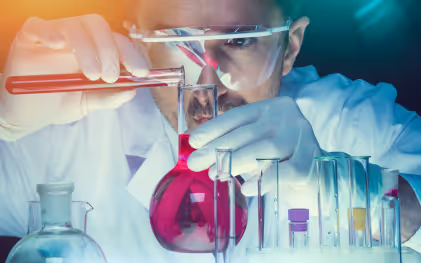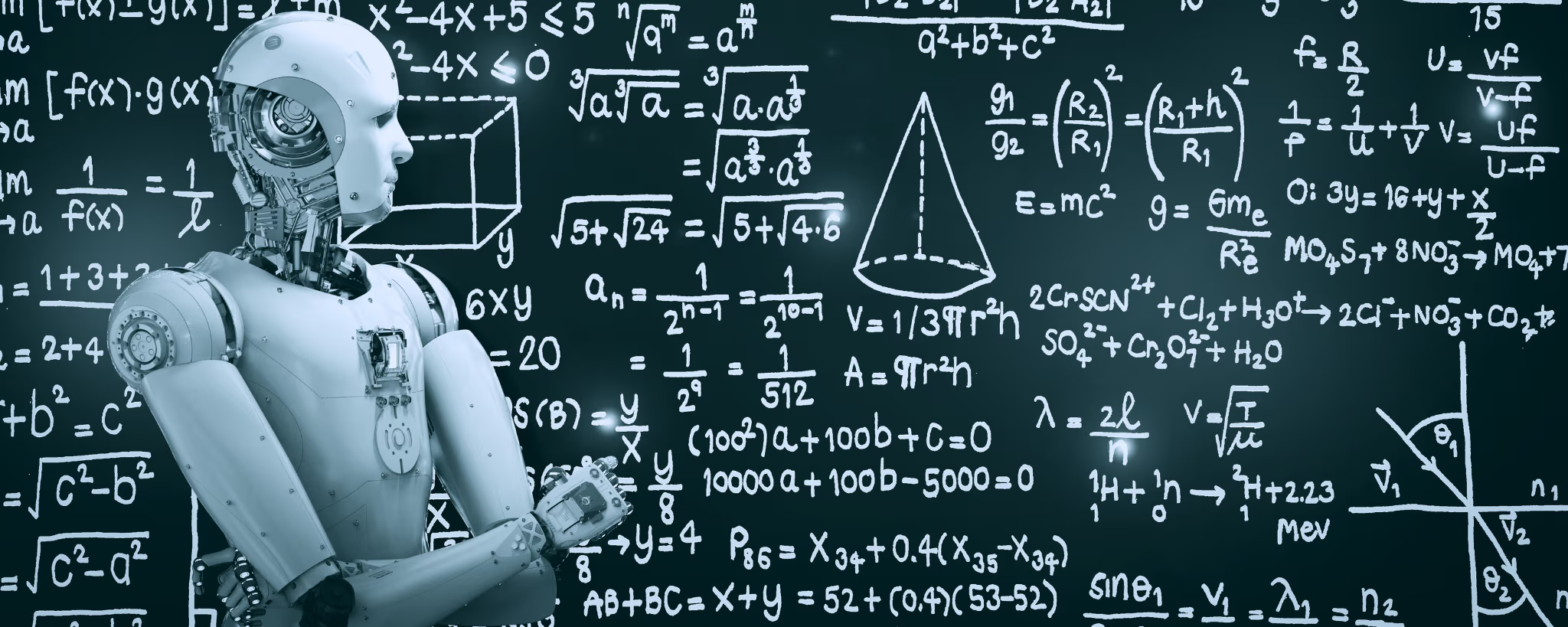Machine Learning: Driving Innovation in Research and Quality Assurance
What if your material data could tell you exactly which formulation works best — before you even run a test?This article shows how R&D and QA teams are using machine learning to predict performance, reduce trial-and-error, and accelerate development with a clear five-step approach.
Too many experiments, long development cycles, and piles of data without actionable insight – these are daily challenges for teams in research and quality assurance. But what if existing data could be used to generate concrete recommendations – automatically, reliably, and at scale? That’s exactly where machine learning comes in.
Whether in formulation development, the detection of process deviations, or quality control: machine learning enables companies to make faster, more accurate decisions based on their existing data. This article explains how to get started, what matters when working with data, models and platforms – and why R&D and laboratory teams in particular stand to benefit.
What Machine Learning Is – and What It Isn’t
Machine learning is a subfield of artificial intelligence (AI). While AI broadly refers to systems that simulate human capabilities, machine learning is about learning from data. A machine learning model identifies patterns in large datasets, makes predictions, and continuously improves – without needing every rule to be explicitly programmed.
We already encounter this technology in everyday life: spam filters, facial recognition, and product recommendations all rely on machine learning. These systems analyse data, adapt automatically, and produce increasingly accurate results.
Classical Statistics vs. Machine Learning
Unlike classical statistics – which rely on predefined assumptions – machine learning searches for patterns independently, even in complex, nonlinear or high-dimensional datasets. For example, while a linear regression requires a clear formula, a neural network can detect hidden interactions between many variables.
Machine learning not only provides better predictions, but also opens up completely new opportunities to understand relationships that were previously hidden.
Especially in material development, where numerous influencing factors act simultaneously, this data-driven approach provides major advantages. ML not only delivers more accurate predictions – it also opens new ways to understand relationships that were previously hidden.
How Machine Learning Is Used in Material Development
In traditional product development, the trial-and-error approach still dominates. Parameters are tweaked one by one, results are analysed, and tests repeated – a laborious and time-consuming process. Methods such as Design of Experiments (DoE) help, but quickly reach their limits as complexity increases.
Machine learning takes a different, data-driven path. Instead of relying solely on experience and physical testing, historical data – from past tests, formulations or measurements – is used to identify relationships. A trained model can then, for instance, predict how a new material composition will perform, or determine which parameters most strongly influence quality.

A Practical Example
In one typical project, a company analysed several thousand historical formulations and their corresponding performance data. The goal was to use machine learning in two ways: first, to predict how well a new formulation would perform before any lab testing; and second, to suggest optimal formulations based on target properties.
The project followed a step-by-step approach — one that has proven effective in many industrial ML applications:
Data Generation:
Reliable data was collected from past experiments and digitalised. This included ingredient combinations, processing parameters, and lab results such as viscosity or hardness.
Data Preparation:
The raw data was cleaned, standardised, and structured so that it could be interpreted not only by humans, but also by machine learning algorithms.
Model Training:
Around 80% of the data was used to train the model. During this phase, the system learned the relationships between inputs (e.g. formulation components) and outcomes (e.g. performance metrics).
Model Deployment:
Once trained and validated, the model was integrated into a practical tool. It could now predict how a new recipe might perform and suggest new formulations based on defined targets.
Model Maintenance:
The model’s performance was continuously monitored. As new data came in from ongoing tests and customer feedback, the model was updated and improved.
The remaining 20% of the original data was held back for testing purposes — to assess how well the model generalised to new, unseen formulations and how reliable its predictions were in practice.
By following this structured approach, the company was able to significantly reduce the number of physical experiments. The model delivered targeted suggestions for promising formulations, accelerating development cycles and improving responsiveness to customer requirements.

Additional Use Cases in Research and Quality Assurance
Machine learning is transforming how R&D and quality teams in materials science approach formulation and process optimisation. Instead of relying on trial-and-error, companies can now harness historical data to predict product performance and identify optimal recipes before they reach the lab. By following a structured five-step process — data generation, preparation, model training, deployment, and maintenance — organisations can accelerate development, improve decision-making, and reduce testing costs. With the right tools and clean data, the path to smarter materials development is closer than many think.
ML also offers significant potential in process optimisation and predictive maintenance. It identifies trends in operational data that may indicate future system failures, enabling proactive maintenance – a clear advantage for manufacturing operations.
Technical Insights: From Linear Models to Neural Networks
Depending on the objective and the available data, different types of machine learning models are used. Simple linear models are transparent and quick to train. They reveal, for example, how strongly a specific factor – such as the concentration of an additive – influences performance. These models are ideal for getting started or for validating known relationships.
More complex tasks – such as predicting performance based on multiple material parameters or under specific processing conditions – require more advanced models like decision trees, random forests, or neural networks. Bayesian neural networks, in particular, are useful when prediction uncertainty needs to be taken into account. Selecting the “right” model is typically an iterative process, involving validation, comparison, and the combination of multiple approaches.
One often overlooked advantage of machine learning models is their analytical power. They don’t just make predictions – they help users understand the underlying relationships. Which features have the greatest impact? Where can the most improvement be achieved? This turns ML into a valuable analysis tool for day-to-day development work.
What Companies Should Know When Using Machine Learning
Success with machine learning depends not only on algorithms, but also on the quality and structure of the data. Many projects fail not during modelling, but during data preparation. Inconsistent labels, different formats, and missing structure in Excel sheets can all become major obstacles. The cleaner the data, the better the model.
It’s also important to realise that machine learning is not a one-time project. Models need to be maintained and updated regularly with new data – like a garden that must be tended over time. Only then can results continue to improve.
And the expertise of domain specialists remains essential. Although the model learns from data, it still needs the knowledge of development and QA teams to assess which features are relevant – and which relationships are truly meaningful.
Organisational Challenges in Implementing ML
Introducing machine learning is not just a technical decision – it’s also a cultural one. In many organisations, the problem isn’t a lack of data, but the absence of a clear strategy for how to use it. Data is often scattered across departments and systems, making integration difficult.
Dealing with uncertainty is another key challenge. Machine learning doesn’t deliver final truths, but probabilities. This calls for a new mindset when interpreting results – and sometimes a shift in decision-making processes.

Acceptance within teams is also crucial. If ML-based recommendations in the lab or QA process are not transparent, trust can quickly erode – along with the impact. That’s why transparent models, pilot projects with tangible benefits, and clear communication between departments are so important for success.
Why a Platform-Based Approach Makes Sense
For many companies, it’s not worth building everything from scratch. Instead, it makes sense to use a dedicated Material Intelligence Platform that combines data management, machine learning and a user-friendly interface. Such platforms make it easier to integrate data from different sources, prepare it appropriately, and apply it directly in ML-supported workflows.
Getting Started
To successfully introduce machine learning in material development or quality assurance, it’s essential to start with a clear question. Which recurring tasks in the lab or formulation work could benefit from data-driven support? Once the objective is defined, the next step is to review the available data: is it complete, structured, and accessible in digital form?
Getting started doesn’t have to be complicated. Even basic models can deliver valuable insights – a deep learning setup is not always necessary. The key is to start small with a clearly defined use case, gather experience, and then scale up step by step.
Conclusion
Machine learning opens new possibilities for data-driven innovation – in both research and quality assurance. When used effectively, it can boost efficiency, support the development of better materials and products, and enable more confident decision-making.
With the right platform, a clear goal, and well-structured data, getting started is easier than many expect.
Want to Learn More?
Machine Learning is reshaping how materials are developed and tested. In a recent webinar, we explained what’s behind ML in more detail, how it can be applied in R&D and QA, and what to watch out for when using it in practice: Watch our webinar here.
